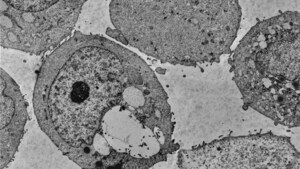COLD SPRING HARBOR, N.Y., Aug. 7, 2024 /PRNewswire/ -- Cold Spring Harbor Laboratory (CSHL) has begun to unravel a mystery millennia in the making. Our story begins 9,000 years ago. It was then that maize was first domesticated in the Mexican lowlands. Some 5,000 years later, the crop crossed with a species from the Mexican highlands called teosinte mexicana. This resulted in cold adaptability. From here, corn spread across the continent, giving rise to the vegetable that is now such a big part of our diets. But how did it adapt so quickly? What biological mechanisms allowed the highland crop's traits to take hold? Today, a potential answer emerges.
CSHL Professor and HHMI Investigator Rob Martienssen had been studying RNA interference, the process of small RNAs silencing genes, for more than 20 years when University of Wisconsin researcher Jerry Kermicle reached out with a curious observation. His experiments crossing semi-sterile teosinte hybrids with traditional maize had caused their offspring to behave very unusually. With normal inheritance, the offspring should have eventually become completely sterile or fertile. But no matter how many times Kermicle crossed the hybrids with maize, all the offspring were semi-sterile, too. What was happening?
To figure it out, Martienssen and graduate student Ben Berube sequenced the genomes from hundreds of pollen grains of the semi-sterile offspring. They discovered the same sections from the teosinte genome were present in each. Martienssen says:
"There were two pieces of the genome, one on chromosome 5 and one on chromosome 6, that were always inherited. That told us the genes responsible must be in those regions."
On chromosome 5, they found that a gene called Dicer-like 2 makes a group of small RNAs that are always in semi-sterile hybrids but not traditional maize. With that finding, the Martienssen lab was able to pinpoint what they call Teosinte Pollen Drive (TPD). This "selfish" genetic system eliminates competing pollen grains that lack the gene drive. It causes maize-teosinte hybrids to pass certain traits through males more often than females. The discovery could have significant implications for the agriculture industry. But in Martienssen's eyes, the finding is even bigger than its potential weed control applications:
"I'm more excited by the evolutionary aspects, what it might mean for the process of domestication, and how it could have been much quicker than we thought."
If teosinte mexicana is "the Neanderthal of maize," Martienssen may have found in TPD corn's "missing link." The breakthrough could explain how corn came to thrive across America—but also why certain small RNAs are so common in plant and animal sperm cells, including ours.
About Cold Spring Harbor Laboratory
Founded in 1890, Cold Spring Harbor Laboratory has shaped contemporary biomedical research and education with programs in cancer, neuroscience, plant biology and quantitative biology. Home to eight Nobel Prize winners, the private, not-for-profit Laboratory employs 1,000 people including 600 scientists, students and technicians. For more information, visit www.cshl.edu.
SOURCE Cold Spring Harbor Laboratory

WANT YOUR COMPANY'S NEWS FEATURED ON PRNEWSWIRE.COM?
Newsrooms &
Influencers
Digital Media
Outlets
Journalists
Opted In






Share this article